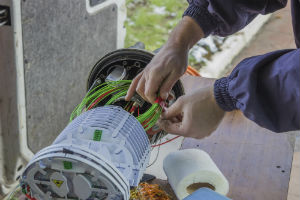The need to prevent crime, detect events, and investigate them has always been a concern for cities. The availability of cheaper and better cameras allows cities to deploy cameras, license plate recognition (LPR), and other systems to ensure the safety of citizens. Apart from deploying cameras, cities must also take into account the best way to connect cameras and other systems with command and control centers. This article discusses some of the available solutions for cities wishing to deploy wireless networks for surveillance.
One of the first questions regarding network design for safe city projects is the availability of fiber optics or wireless networks. In practice, in most cases a combination of the two is being deployed with a slight advantage for wireless networks.
What Types of Wireless to Choose?
Wireless networks are cheaper to deploy than a wired network, however they come with several constraints. Bandwidth can fluctuate; some network topologies like mesh networks require a high degree of technical expertise and the growing demand for bandwidth (due to ever-increasing camera resolutions) can make a wireless network under-sized during the system’s life cycle. The choice of the right infrastructure is therefore very important.
 Fiber optics has the advantage of greater bandwidth,
Fiber optics has the advantage of greater bandwidth,
but is more difficult and costly to install compared to Wi-Fi,
often resulting in combination fiber-wireless solutions.
The wireless solutions can be divided according to the frequency they use and the type of link, whether it connects a single camera or backhauls a large number of cameras. The common frequencies are sub-6 GHz frequency (also known as Wi-Fi or 5 GHz), and microwave and millimeter wave technology (mmW).
Sub-6 GHz frequency is most widely utilized today. Wi-Fi operates in an unlicensed frequency spectrum, either in the 2.4-GHz band or the 5.8-GHz band. On the advantages side, Wi-Fi equipment tends to be low cost and delivers high throughput. There is no maintenance fee as the spectrum it uses is unlicensed and installation is relatively simple. The most significant disadvantage with Wi-Fi results from the fact that it uses an unlicensed spectrum, and is hence prone to interference and also network latency which impacts real-time viewing and PTZ control. This problem is known as “spectrum congestion” and causes Wi-Fi-based links to be an unreliable solution, especially in dense urban areas.
Point-to-point (P2P) microwave equipment supplies throughputs ranging from several tens of Mbps up to a few hundred of Mbps and distances exceeding 10 miles. The main advantages of this type of solution are its use of licensed spectrum which enables close to 100-percent reliability and a relatively easy installation. However, this equipment is typically significantly more expensive than Wi-Fi-based solutions, and also carries a significant annual fee for use of the licensed spectrum.
Another option is millimeter wave wireless technology (or mmW). This technology operates at the 60-, 70-, 80-GHz bands. Since these bands are not as congested and have significantly better interference suppression characteristics, the huge amount of bandwidth available in these frequencies facilitates very high throughput data transmission. "mmW wireless solutions deliver valuable advangtages, comparable to Wi-Fi," said Yigal Leiba, CTO of
Siklu Communication. Millimeter wave wireless technology offers greater throughput (up to 2 Gpbs) and can provide support to multiple multi-megapixel cameras operating at full frame rate. “In this sense, it is a wireless solution which is futureproof. The systems will not ‘run out’ of bandwidth as cameras are improved and upgraded,” added Leiba.
However, mmW technology has two main disadvantages: cost and susceptibility to weather conditions. Cost is most usually at the high end when compared to Wi-Fi-based solutions.
Regarding susceptibility to weather conditions – Millimeter wave frequency bands are influenced by precipitation. In heavy rainfall conditions the quality of the signal is reduced. Consequently, in heavy rain condition, the range of millimeter wave links is limited to slightly more than 1/2 mile at 60GHz and about 2 miles at 70/80GHz. However, this range is sufficient for most safe city installations and can be improved with smart network planning.
Due to its higher price, there are surveillance professionals who believe that using mmW for single-camera connection might be overkill; however, it has large potential and value for backhauling a large number of cameras to the network, or when supporting ring or mesh topologies with add/drop capacity at each camera site. Furthermore, mmW provides a high throughput and therefore is ideal to extend fiber network to places where fiber cannot be trenched easily.
Saving Bandwidth
As safe cities projects become larger and larger, so does the need to reduce bandwidth consumption. This need is both financial — bandwidth is expensive — as well as operational. Conserving bandwidth helps avoid network congestion.
One option is the use of edge storage, storing the video on the cameras and streaming it on demand. However edge storage is problematic in terms of reliability and the risk that devices might be damaged or stolen on purpose. The use of video concentrators, or video proxies is another option. “We did a safe city project with 5,500 cameras, which are monitored from 15 regional centers,” described Aluisio Figueiredo, CEO of Intelligent Security Systems.
Systems integrators should pay close attention to the network design and choice of systems in safe city projects. Transmission is often a secondary consideration in safe city projects; however, it is important that it is on-par with the rest of the system. Giving networking the right attention is imperative to ensure full utilization of the cameras and their capabilities.